Sepsis Digital alerts highlight to clinicians the risk of sepsis, hence increasing clinical effectiveness.
It primarily identifies patients that need antibiotics urgently and administers antibiotics within the recommended time frame of 1 hour from first signs of suspected sepsis.
How the patient gets on the Sepsis Pathway?
There are 4 ways a patient can get on the Sepsis Pathway:
- Manual activation
- Presenting Problem at Triage, or BTF Observations trigger a screening tool
- Multiple fluid IV Bolus orders
- Lactate > 2.4
Once the patient is on the Pathway, there are a series of alerts on opening/closing the patient chart, to prompt on:
- Charting the Decision to Treat as Sepsis
- Ordering fluids and antibiotics
- Administering the antibiotics
Please refer to the Quickstart below for more information on manual initiation of the sepsis pathway.
https://learning.schn.health.nsw.gov.au/ed-sepsis-pathway
Vital Signs & Observations Screening
FirstNet will monitor for the following documented results:
- Neonate <28 days old, AND temperature <36 or >38
- Presenting problem: Fever neonate or Fever Immunocompromised or Transplant Related
- 1 red zone criteria (HR, SBP, Temp, RR, SpO2, AVPU)
- 3 yellow zone criteria (HR, SBP, Temp, RR, SpO2, AVPU, capillary return)
- Persistent Tachycardia over 2 hours
If one of the criteria are met, the following Notification appears:
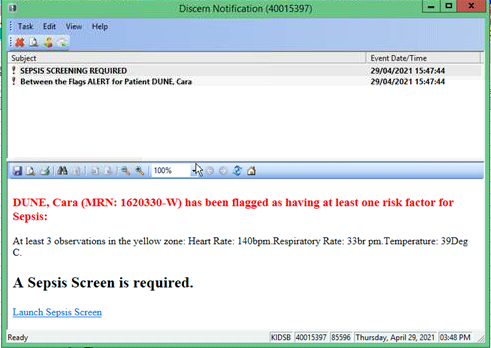
- Click Launch Sepsis Screen, to perform the screening
- Note there may be 2 notifications – for Sepsis screening, and a BTF Alert – that must be actioned
- Clicking the hyperlink launches the Sepsis Screen form.
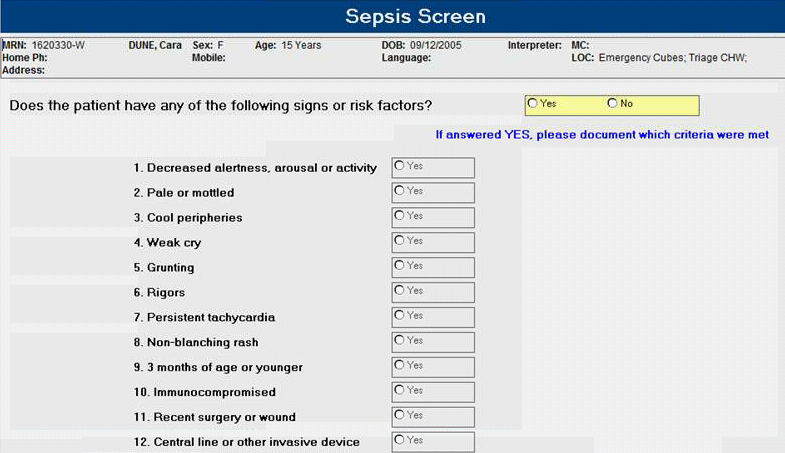
- Select No if the patient does not exhibit any of the risk factors.This also sets a time limit of 1 hours grace before a new screen can be requested by new sets of observations
- Select Yes if the patient shows any of the listed risk factors.
This drops the Sepsis Bomb onto the tracking board (and hidden order), and initiates the same alert flow as following the manual trigger
Note: Only observations charted on Triage forms or on the BTF Observations form will trigger this process.
If the screening was not done, the next Nurse to open or close the patient chart will receive this alert:
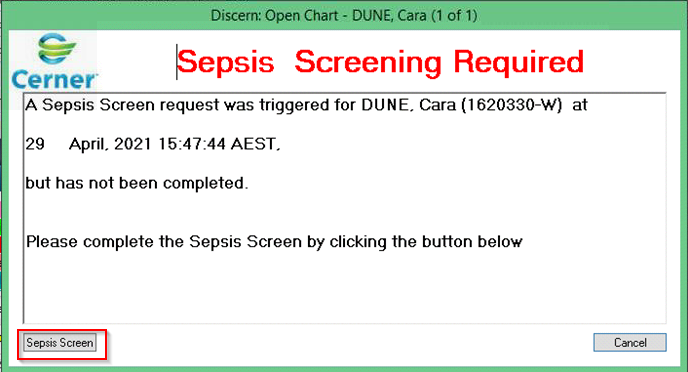
Please refer to the Quickstart below for more information on manual initiation of the sepsis pathway.
https://learning.schn.health.nsw.gov.au/ed-sepsis-pathway
Multiple IV Bolus Orders
- FirstNet will track how many boluses of sodium chloride 0.9%, Plasma Lyte and Hartmann's are ordered.
- If ordering multiple IV fluid boluses, the sepsis alert comes up on 2nd or 3rd order of those types. System identifies a certain threshold and puts the alert up

- On attempting to sign the 2nd or 3rd fluid bolus order (depending on total mL/kg of previous doses), staff will see the following alert:
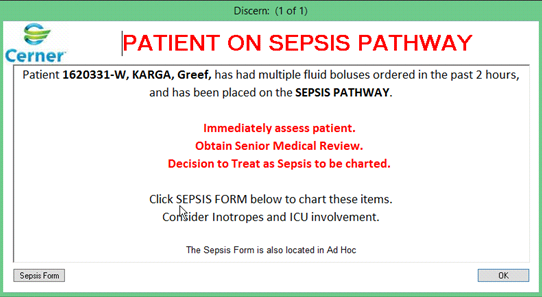
- At this point the Sepsis Bomb is placed automatically on the Tracking Board
- Click Sepsis Form to chart the Decision to Treat as Sepsis.
- Note after signing the form, you will still have to sign your order.
- Once the patient is placed on the Sepsis Pathway by the Bolus rules, the same workflow as the manual trigger is followed.
- The only slight difference is in the initial alerts to document the decision – they refer to the reason the Sepsis Pathway was triggered, as in this case it was done by the system rather than manual or screening processes.
- This alert will continue to operate even if the other alerts are paused due to charting Sepsis as Possible (see https://learning.schn.health.nsw.gov.au/ed-sepsis-pathway). You cannot chart Sepsis is Possible from the alert triggered from multiple bolus orders.
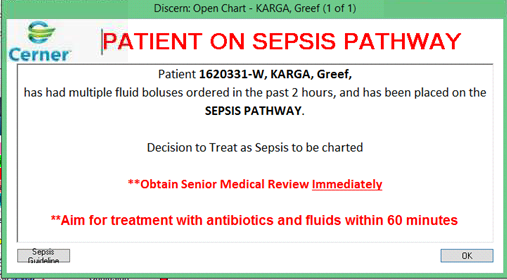
Please refer to the Quickstart below for more information on manual initiation of the sepsis pathway.
https://learning.schn.health.nsw.gov.au/ed-sepsis-pathway
Abnormal Lab Results:
FirstNet monitors for abnormal pathology results:
- Lactate > 2.4mmol/L
If any of these criteria are met, the system automatically triggers the Sepsis Bomb and hidden order
![]()
- Once the patient is placed on the Sepsis Pathway by the Lab Result rules, the same workflow as the manual trigger is followed.
- The only slight difference is in the initial alerts to document the decision – they refer to the reason the Sepsis Pathway was triggered, as in this case it was done by the system rather than manual or screening processes.
- This alert will continue to operate even if the other alerts are paused due to charting Sepsis as Possible (see https://learning.schn.health.nsw.gov.au/ed-sepsis-pathway). You cannot chart Sepsis is Possible from the alert triggered from an abnormal lab result.
Medical Alert:
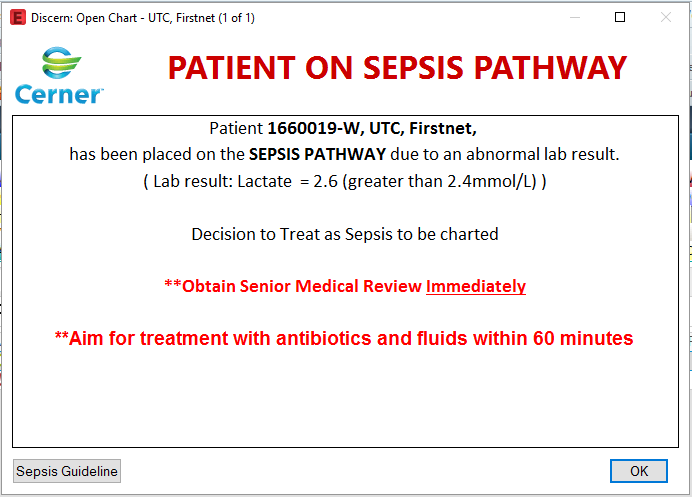
- Once the patient is placed on the Sepsis Pathway by the Lab Result rules, the same workflow as the manual trigger is followed.
- The only slight difference is in the initial alerts to document the decision – they refer to the reason the Sepsis Pathway was triggered, as in this case it was done by the system rather than manual or screening processes.
Nursing Alert:

Note: Please read and action alerts as needed. If not done appropriately, alerts get triggered repeatedly.